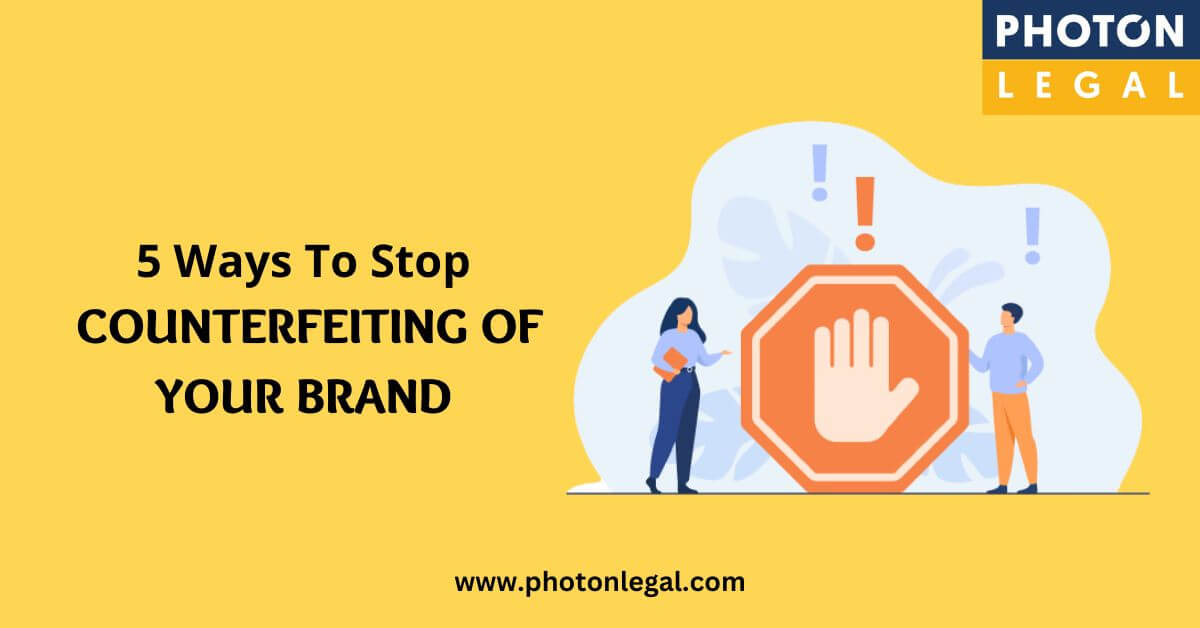
Introduction
Counterfeiting is a worldwide issue that currently affects virtually everyone involved in the business. It is not uncommon to encounter counterfeit versions of popular brands like GUCCI, Woodlands, Adidas, Levi’s, etc. These goods are fakes that pose as famous brands in order to undercut the market price and make a profit. These ads trick consumers into thinking they are getting the real deal when in fact they are not.
The trade value of counterfeits in the USA is expected to reach $991 billion by 2022. [1] India has lost around 1 trillion Rupees to counterfeiting [2], especially during the pandemic.
Among the many ways in which counterfeiting hurts legitimate businesses, here are just a few:
- Counterfeit goods reduce profits for legitimate companies.
- Counterfeit goods tend to have a devastating effect on the brand’s image and consumer confidence.
- The partnership and consumer trust that had been established by brands painstakingly is broken.
- Instead of putting money into research and development, companies are forced to allocate resources toward combating fakes.
However, with the advancement in technology and law, it is not impossible to stop counterfeiting.
Below mentioned are the 5 ways to stop counterfeiting of brands.
Protection against counterfeiting
1. Protection of necessary Intellectual Property rights
Before enforcing rights in IP, it is important to protect different aspects of a product/service. The rademark protects the brand name/logo/tagline/packaging associated with the product. Copyright shall protect the design of the logo if any, taglines, software codes, etc. Patent will help to protect any new invention.
A strong IP portfolio should be built by way of appropriate registrations as they act as primary evidence in any enforcement proceeding. Since the priority date can be claimed, counterfeits do not stand a chance against such brands. The brands also take a step forward and educate their consumers about IP rights.
In a case filed by Hero Honda[3], their logo was wrongly being used by another service provider which was causing them a huge loss. Due to this violation of trademark, they got 5 Lac Rupees as damages.
2. Civil and Criminal Enforcement of violation
Considering that IP rights are violated majorly, brands can take legal action against counterfeits. Civil remedies are available for all kinds of IP protection, but criminal remedies are available for violations of trademarks, and copyrights.
In case of civil litigation, the courts shall pass an injunction order against the counterfeits and also order to pay damages including a rendition of accounts to assess the revenue gained through the unauthorized sale and marketing of counterfeit goods. For example, software piracy is very robust, especially buying pirated versions of Microsoft Office at a lesser rate. Microsoft initiated a civil case against counterfeits and was awarded compensatory damages along with a permanent injunction.[4]
In case of criminal proceedings, violation of IP is a cognizable offence where the police have the power to search, seize, and arrest on a court warrant. The court may punish the offender with either imprisonment or fine or both. In a recent US case, four offenders were arrested for allegedly importing goods from China and then imprinting trademarks of famous brands like UGG boots, Nike Air Jordans, Timberland boots, and Beats headphones. The value of the entire counterfeited goods was more than $130 Million.[5]
3. Using technology to safeguard the brand
Technology has advanced such that on one hand there is an increase in counterfeiting goods and on the other there are new technologies being used to curb the menace. One of the major technologies used is to track and trace the products and provide end-to-end protection of the supply chain.
These methods may include serialization of products or putting a QR code for scanning, or imprinting digital watermarks to show the owner’s identity, using nanotechnology to put invisible images on the products, barcodes and RFID codes for track and tracing systems, using artificial intelligence and connecting the same to the smart phones etc. Enforcing advanced technologies will maintain the trust of the customers in the product as they have the liberty to verify the identity of the products. LVMH, the luxury brand, has adopted a blockchain technology where the consumers can scan the label and get information about the product, additionally, it shows info whether the product is fake or counterfeited.
The Government of India is also passing regulations to safeguard the brand.[6] For example, a mandate that QR codes should be present on the labels of all pharmaceutical products to track and trace them. This mandate shall be in force from Jan 2023. Similar tracing system is put in place for tracing of seeds to provide premium quality seeds for agriculture.
4. Appealing to the take down policy of e-commerce websites
E-commerce websites are a hub of fake products as they are not territorial bound but the IP rights of a trader is jurisdiction bound. So, a counterfeit product can be traded outside the territory of the country in which the brand sells and trades. So, the e-commerce websites who act as intermediary are held responsible to come up with anti-counterfeiting methods.
Every e-commerce website has a policy for IP infringement and reporting such counterfeit goods. For example, Amazon has a registry where the brand owners should first register their trademarks, and only after verification they are allowed to list their products on the website. Then the infringements can be reported through a notice. If the notice is valid according to Amazon, it will remove the infringing content from the website. The Government of India has also come up with draft national e-commerce policy with definite steps and suggestions for e-commerce websites to follow against counterfeit goods.
5. Creating awareness about counterfeit products
Creating awareness among the consumers and employees of the brands is very necessary. Brands may come up with their own guidelines as to how to communicate their IP rights to their ideal consumers and make aware of the counterfeits in the market. Brands can also take help of legal counsels to strategize their brand protection schemes. Having an associate with strong legal team shall always come in handy to the brands
We at Photon Legal actively work towards brand protection and create awareness regarding counterfeit products. We also provide necessary services to brand owners to protect their brand. We conduct webinars to educate the common people. We recently conducted a three-day webinar on ‘Movement against online counterfeits’ where we invited various lawyers and brand owners to share their strategies and methods taken against counterfeit products. We also provide necessary services to brand owners to protect their brand.
Conclusion
Counterfeit goods impact not just the company but also the economy and society. It is very important for every brand to take actions against their counterfeits to safeguard their reputation, revenues and profits. It is ideal that the brands have IP strategies to combat fake goods and imitations. Brands can also seek help external help when required. Above all, awareness about the counterfeit goods among the consumers is vital as they are the end of the supply chain and they shall be victims of such goods.
References:
[1] https://iccwbo.org/publication/economic-impacts-counterfeiting-piracy-report-prepared-bascap-inta/ [2]https://www.aspaglobal.com/pre_upload/nation/1623216858-4730baa0efdb83aba174859af0a3a6a5-Report%20The%20State%20of%20Counterfeiting%20in%20India%202021.pdf. [3] Hero Honda Motors Ltd v. Shree Assuramji Scooters, 2006 (32) PTC 117 Del. [4] Microsoft v. Kiran and Anr, 2007 (35) PTC 748 Del. [5] https://www.justice.gov/usao-edny/pr/four-defendants-arrested-multimillion-dollar-counterfeit-goods-trafficking-scheme [6] https://www.aspaglobal.com/counterfeiting-regulations.

